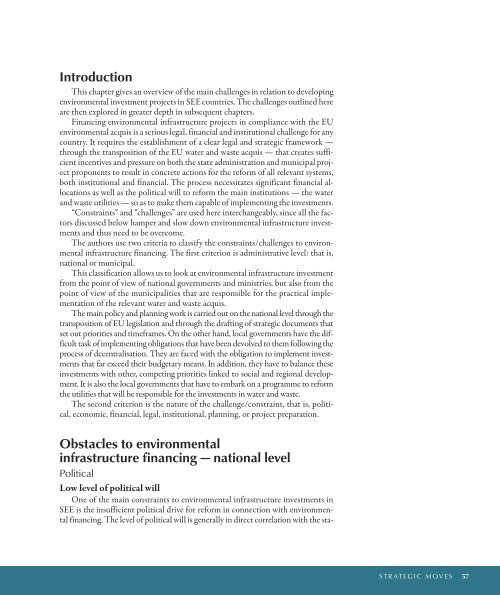Strategic Moves - Regional Environmental Center for Central and ...
Strategic Moves - Regional Environmental Center for Central and ...
Strategic Moves - Regional Environmental Center for Central and ...
Create successful ePaper yourself
Turn your PDF publications into a flip-book with our unique Google optimized e-Paper software.
Introduction<br />
This chapter gives an overview of the main challenges in relation to developing<br />
environmental investment projects in SEE countries. The challenges outlined here<br />
are then explored in greater depth in subsequent chapters.<br />
Financing environmental infrastructure projects in compliance with the EU<br />
environmental acquis is a serious legal, financial <strong>and</strong> institutional challenge <strong>for</strong> any<br />
country. It requires the establishment of a clear legal <strong>and</strong> strategic framework —<br />
through the transposition of the EU water <strong>and</strong> waste acquis — that creates sufficient<br />
incentives <strong>and</strong> pressure on both the state administration <strong>and</strong> municipal project<br />
proponents to result in concrete actions <strong>for</strong> the re<strong>for</strong>m of all relevant systems,<br />
both institutional <strong>and</strong> financial. The process necessitates significant financial allocations<br />
as well as the political will to re<strong>for</strong>m the main institutions — the water<br />
<strong>and</strong> waste utilities — so as to make them capable of implementing the investments.<br />
“Constraints” <strong>and</strong> “challenges” are used here interchangeably, since all the factors<br />
discussed below hamper <strong>and</strong> slow down environmental infrastructure investments<br />
<strong>and</strong> thus need to be overcome.<br />
The authors use two criteria to classify the constraints/challenges to environmental<br />
infrastructure financing. The first criterion is administrative level: that is,<br />
national or municipal.<br />
This classification allows us to look at environmental infrastructure investment<br />
from the point of view of national governments <strong>and</strong> ministries, but also from the<br />
point of view of the municipalities that are responsible <strong>for</strong> the practical implementation<br />
of the relevant water <strong>and</strong> waste acquis.<br />
The main policy <strong>and</strong> planning work is carried out on the national level through the<br />
transposition of EU legislation <strong>and</strong> through the drafting of strategic documents that<br />
set out priorities <strong>and</strong> timeframes. On the other h<strong>and</strong>, local governments have the difficult<br />
task of implementing obligations that have been devolved to them following the<br />
process of decentralisation. They are faced with the obligation to implement investments<br />
that far exceed their budgetary means. In addition, they have to balance these<br />
investments with other, competing priorities linked to social <strong>and</strong> regional development.<br />
It is also the local governments that have to embark on a programme to re<strong>for</strong>m<br />
the utilities that will be responsible <strong>for</strong> the investments in water <strong>and</strong> waste.<br />
The second criterion is the nature of the challenge/constraint, that is, political,<br />
economic, financial, legal, institutional, planning, or project preparation.<br />
Obstacles to environmental<br />
infrastructure financing — national level<br />
Political<br />
Low level of political will<br />
One of the main constraints to environmental infrastructure investments in<br />
SEE is the insufficient political drive <strong>for</strong> re<strong>for</strong>m in connection with environmental<br />
financing. The level of political will is generally in direct correlation with the sta-<br />
S T R AT E G I C M O V E S 57






